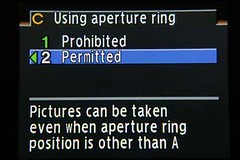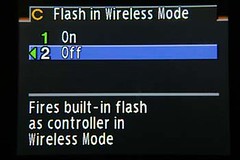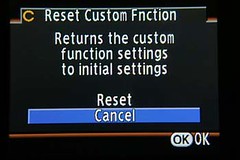The final part to the custom menu settings.
The recordable image number setting switches between showing the approximate number of shots available on the memory card and the number of shots currently contained on the memory card.
The first choice is the approx amount available and the second is the current count.
The initial zoom display sets the initial zoom or magnification in the display screen.
You can choose between 1.2, 2, 4, 8, and 16 times magnification.
Auto image rotation will rotate your images in playback by +/- 90 degrees if you took the photo with the camera in vertical format.
The images will be smaller in playback since the longest side of the image has to be shrunk to fit the shortest side of the screen.
If I'm taking vertical shots and viewing them on camera on the tripod I don't turn this feature on. In fact I usually have it off as I want to see the image as large as I can. I'm pretty much used to viewing images turned sideways by now anyways.
Saving rotation info adds a flag to the exif data that says which way the image should be rotated. When you upload to flickr or other photo sites with this feature the image will be viewed in it's proper orientation.
There are a lot of sites that do not do this though.
The using aperture ring setting is useful if you have a manual lens with an aperture ring. This is what makes the new digital line of Pentax cameras compatible with the older M type lenses.
If you have an auto A or FA lens and still prefer to use the aperture ring then turn this setting on. The A/FA lenses will still work when setting the aperture via the dials if the aperture ring is set to A. You can safely leave this setting turned on if you have manual lenses you use or like to use the aperture rings.
(edit 22 Sep 2010) When using M lenses and setting the aperture via the aperture ring you must use stop down metering (K10D Operating Manual page 210). By using stop down metering (turn the on/off switch past on to the aperture blade symbol) the lens is stopped down to the setting on the aperture ring and an exposure reading is taken. The camera then sets the shutter speed for a correct exposure. If you find your manual lenses under expose then set some corresponding exposure compensation to offset the amount of under exposure. (edit)
The flash in wireless mode is only useful if you have off camera Pentax (or compatible) flashes. This setting will allow the on camera flash to help expose the frame or not depending if it is turned on or off.
It might be useful if you only have one off camera flash and want some fill, but if you have multiple flashes set up you probably don't want it on.
We'll cover wireless flash at a later date.
The reset custom function does just that, it resets the custom settings to default. If you changed something in the custom settings and can't get the camera to work like you want and don't remember what you changed then just reset the custom settings.
This is the final setting in the custom settings menu.
Next time we'll start on the camera's Mode Dial. Isn't that what you have all been waiting for?
[edit 23 June 2008]OK so the next segment wasn't the mode dial. It's the function menu.








No comments:
Post a Comment